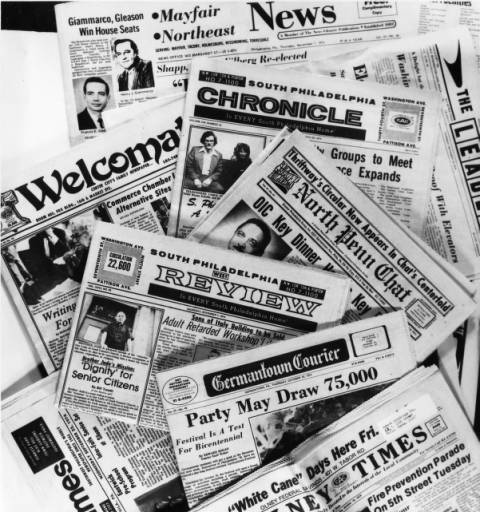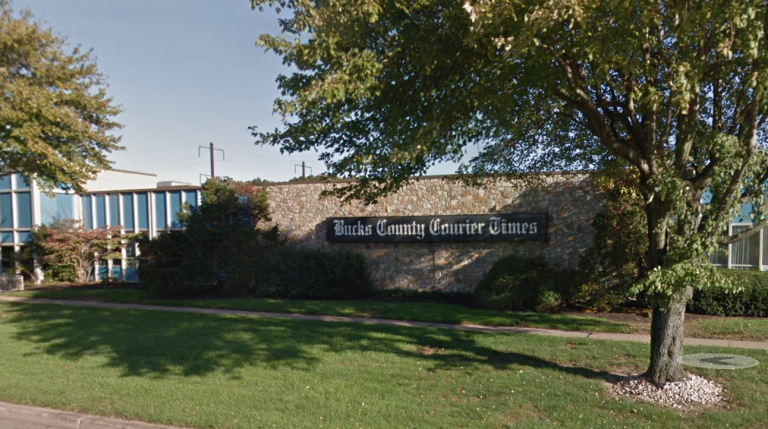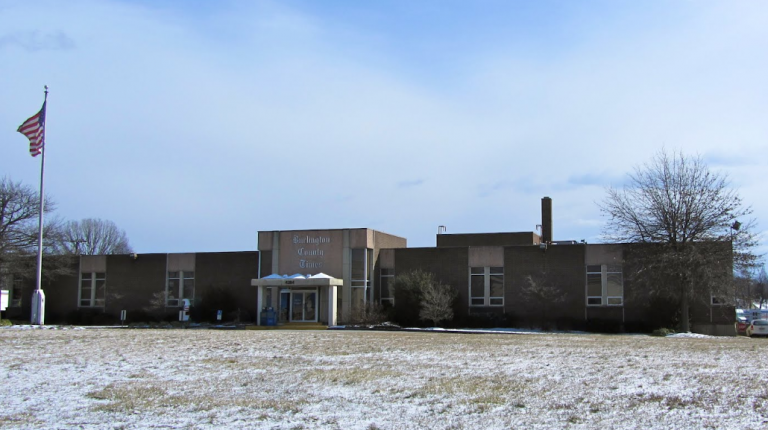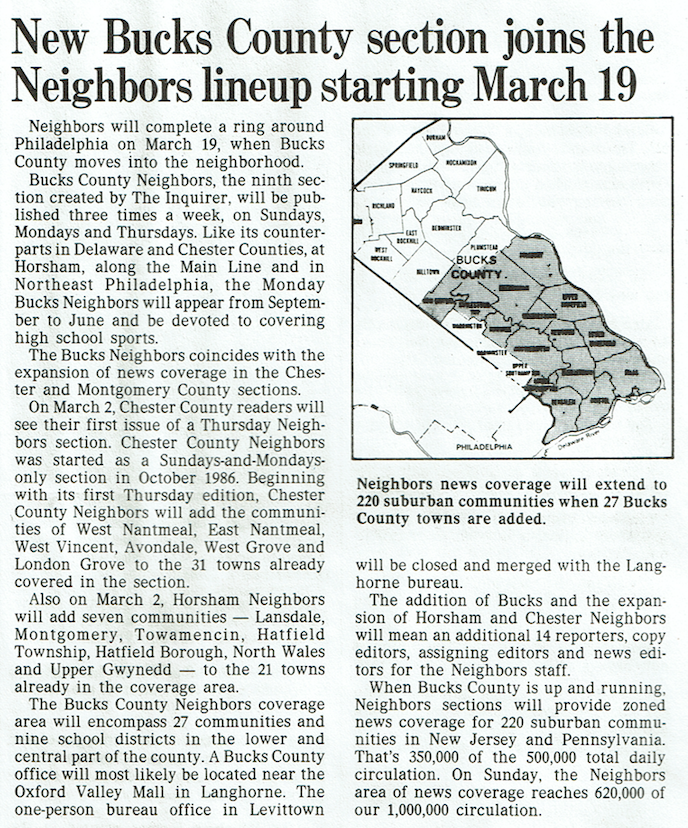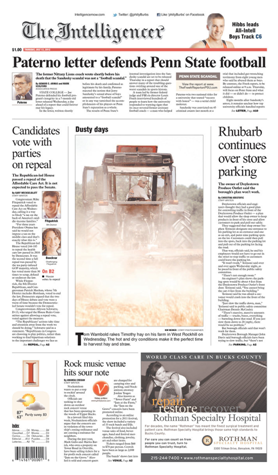Newspapers (Suburban)
Essay
In the decades following World War II, the dramatic demographic, industrial, and retail decentralization that transformed the United States into a suburban nation also caused a major restructuring of the American newspaper industry. The massive influx of people and commerce into the suburbs led to rapid growth for numerous vibrant and profitable suburban daily and weekly newspapers in metropolitan areas, including the Philadelphia region. Suburban presses covered local events and issues extensively and provided retailers with targeted access to suburban consumers, thereby generating steadily rising circulation and advertising revenues at a time when consolidations and closings became a reality for urban dailies like the Philadelphia Evening Bulletin.
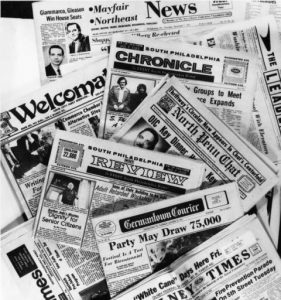
Traditionally referred to as “grassroots” or “community” presses, these papers came in a variety of shapes and sizes but had much in common. Some, including Norristown’s Times-Herald (1799) and Doylestown’s Daily Intelligencer (1804), originated near the turn of the nineteenth century. Many others were born during the industrial era. The Chester Daily Times was established in 1876 and the Bristol Daily Courier in 1910 in Bucks County, Pennsylvania. New Jersey’s Gloucester County Times began in 1897 as the Woodbury Daily Times. Most were independently owned and operated, published in the afternoon, and maintained circulations that paled in comparison to Philadelphia’s large-circulation dailies.
Despite their modest size, the community presses provided a vital service to their readers through extensive coverage of local happenings often ignored by Philadelphia papers. Editors and publishers operating in the surrounding counties filled their pages with coverage of local political and business developments, court proceedings, school board meetings, marriages, and community events such as parades, fundraisers, and holiday celebrations. Their papers also served as local filters for the larger regional, national, and international stories acquired from the news wire services. As a result, the local presses often served as the voices of their communities, editorializing on issues large and small and highlighting intrusions that had the potential to upset the economic, social, or cultural status quo. Retaining high local readership levels was only part of the equation, however, as the community presses also relied heavily on advertising revenues from local businesses and classified ads to ensure profitability.
A Niche Without Competition
By carrying news and advertising not generally found in the Philadelphia Bulletin or Inquirer, community presses carved out a secure, if circumscribed, niche during the first half of the twentieth century. Although many of their readers also read one or more of the Philadelphia dailies, the papers’ provincial focus ensured that they would have little competition. They operated in the same metropolitan area as the Bulletin and Inquirer but did not really compete in the same marketplace.
The surge of residents into America’s nascent suburban areas following World War II altered this dynamic greatly. Between 1945 and 1962, newspapers operating in the suburbs of America’s ten largest metropolitan areas gained more than eight million more new readers than their urban counterparts. Established community weeklies and dailies immediately reaped the benefits of the new arrivals and often expanded their existing operations. In some areas, the construction of large suburban subdivisions and shopping centers fostered the emergence of wholly new newspapers. In other locales, urban papers followed the exodus out of the nation’s cities, built new plants in the suburbs, and either transformed themselves into suburban dailies or provided suburban versions of their urban products.
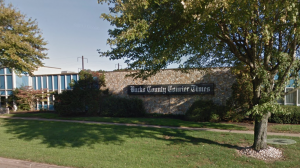
Nearly a dozen daily newspapers and a large coterie of weeklies operated in the seven Pennsylvania and New Jersey counties surrounding Philadelphia at the outset of the post-war era, while three large dailies served the city: the Evening Bulletin, Inquirer, and the tabloid Daily News. In Bucks County, the construction of the Levittown subdivision and subsequent arrival of more than sixty thousand new residents provided the foundation for the weekly Levittown Times, launched by publisher Ira L. Joachim (1925-2014) in 1952. In traditionally parochial fashion, Joachim promoted the paper as the only reliable source for news specific to Levittown and filled its pages with stories that helped residents navigate the ins and outs of suburban life. The publisher’s editorials often encouraged “Levittowners,” as they came to be known, to form civic organizations and engage in discussions about important issues, including property taxes, municipal government, and how best to maintain the community’s idyllic appearance. Joachim’s provincial approach proved popular, and the paper drew advertising from retailers with stores in Levittown’s large Shop-A-Rama shopping center.
In 1954, Joachim sold the Times to S.W. Calkins (1898-1973), the founder of Calkins Newspapers Inc., who converted the paper into an evening daily. Calkins also purchased the Doylestown Daily Intelligencer and Bristol Courier that same year. He later expanded into New Jersey by founding the Burlington County Times in 1958 to capitalize on the construction of the third Levittown subdivision. In 1966, Calkins created the Bucks County Courier Times by merging the Levittown and Bristol papers.
A Magnet for Advertising
Calkins’ newspaper network proved immediately successful, due in no small part to the increased advertising revenues the papers generated. Community papers typically tied advertising rates to their circulation levels and thus charged substantially less than large-circulation dailies like the Evening Bulletin or Inquirer, which offered broad but expensive coverage. Calkins’ dailies proved highly attractive to national retailers with new stores in the area. With seemingly ever-increasing readership among the upwardly-mobile suburban families prized by advertisers, papers like the Levittown Times and Bristol Courier offered targeted access to consumers at a much lower cost. Adding to the allure, advertising could be packaged across the newspapers. By the end of the 1950s, Calkins’ papers had established an entrenched position in Philadelphia’s fast-growing northern suburbs.
A similar push to capture readers and advertisers took place east of Philadelphia in Camden County, New Jersey, where the owners of the Courier-Post joined the rush of residents and retailers to the suburbs. In 1947, Harold A. Stretch (1891-1951) purchased and merged Camden’s Morning Post and Evening Courier daily newspapers, forming the Camden Courier-Post. Seven years later, the Stretch family moved the paper’s operations from its headquarters at Third and Federal Streets in Camden to a gleaming new plant in the suburbs near Route 38 in Delaware Township. Located amid a growing network of highways that eventually crisscrossed southern New Jersey, the new plant made afternoon home delivery to suburban readers much easier. The plant’s technologically advanced presses, which could print multi-colored advertisements and inserts, attracted advertisers and foreshadowed the advertising opportunities created in 1961 with the opening of the Cherry Hill Mall, the first climate-controlled, enclosed shopping center in the eastern United States.
The Stretches sold the Courier-Post to Gannett Company Inc., a growing newspaper chain, in 1959. The mall’s opening two years later and the continued residential development of Camden County’s suburbs proved a financial boon. In 1962, the Courier-Post gained over one and a half million additional lines of advertising over the previous year, and in 1965, it ran more lines of classified advertising than the Evening Bulletin. The paper’s circulation topped one hundred thousand for the first time during the 1960s as well. The Courier-Post proved so lucrative that Gannett later purchased an additional group of ten weekly newspapers based in Camden and Burlington Counties. When combined with the Courier-Post, the papers gave Gannett a dominant position in the South Jersey portion of the Philadelphia newspaper market.
While Calkins and Gannett were carving out positions in the northern and eastern parts of the metro area, publisher Ralph Ingersoll (1900-85) began acquiring newspapers west of Philadelphia in Delaware and Montgomery Counties and in New Jersey. Between 1961 and 1967, Ingersoll acquired the Trentonian (Trenton, New Jersey), the Delaware County Daily Times, the Pottstown Mercury, a small daily operating in Montgomery County, and Suburban Philadelphia Newspapers Inc., a chain of weekly papers that included the Main Line Times and the News of Delaware County, one of the largest-circulation weeklies in the country. Similar to the Courier Post in New Jersey, the Delaware County Daily Times had been the Chester Times until its move from the City of Chester to Upper Darby Township in 1959. Its relocation capitalized on the substantial residential and retail growth taking place in the suburbs.
A Ring Around Philadelphia
Led by the Calkins, Ingersoll, and Gannett chains, suburban newspapers emerged as a significant economic factor in the Philadelphia newspaper market during the 1960s, collectively creating a ring around Philadelphia and siphoning circulation and advertising revenues from the Evening Bulletin and Inquirer. The Evening Bulletin was long the dominant force in the metro area and the paper of record for most Philadelphians. Consistently ranking among the nation’s largest-circulation dailies for much of the twentieth century, the paper’s slogan, “In Philadelphia, Nearly Everybody Reads the Bulletin,” seemed apropos. Philadelphia’s status as the commercial heart of the region helped ensure the Bulletin brought in substantial advertising revenues from national and local retailers as well. The Inquirer, owned until 1969 by Walter Annenberg (1908-2002), ranked a not-too-distant second in the regional market. Less a paper of record than a mouthpiece for its outspoken publisher, the Inquirer benefited from its status as a morning paper, as it did not compete directly with the Bulletin for readers or advertising. The Inquirer’s large Sunday edition, whose circulation at times hovered near one million subscribers, helped close the Bulletin’s weekday circulation and advertising lead.

Executives at the Evening Bulletin were especially aware of the trend of competition from the suburbs and actively attempted to combat the suburban papers’ growth, but they were hamstrung in their efforts. In 1964, the Federal Communications Committee thwarted their attempts to build a network of affiliated suburban papers in the region via acquisitions and consolidations on the grounds that doing so would violate federal antitrust laws.
Without the staff and printing facilities that would have been gained from acquiring established suburban newspapers, Bulletin executives attempted to cover the suburbs from their headquarters in Philadelphia with strategic semi-weekly zoned editions. The zoned editions attempted to compete in the areas where the Calkins, Ingersoll, and Gannett papers were prospering, but they were broad, shallow, and ineffective. Approaching the metro area’s many autonomous boroughs, townships, and municipalities through a regional lens prevented the Bulletin from supplying suburban readers with the consistent, in-depth coverage of local government affairs, public school board meetings, and high school sports they received from their local dailies and weeklies. The zoned editions failed to match the quality and depth of the suburban papers, and they failed to lure more readers and advertisers.
The suburban presses continued to prosper during the 1970s and 1980s, and their collective dominance of the growing suburbs helped reshape the regional newspaper market. By 1973, more than 150 newspapers with a cumulative circulation in excess of a million and a half readers operated in the thirteen counties surrounding Philadelphia. Without a strong presence in the suburbs, Philadelphia’s urban dailies each saw their market share decline. The Evening Bulletin felt the sting of this competition acutely as an evening daily competing head-to-head with suburban papers also published in the afternoon. The Bulletin’s failed attempts to break into the suburban markets contributed significantly to an economic freefall from which it never recovered. Meanwhile the purchase of the Inquirer by the national Knight-Ridder Newspapers chain in 1969 and the subsequent hiring of Eugene L. Roberts (b. 1932) as executive editor helped transform the daily into a nationally recognized, Pulitzer Prize-winning paper. In 1980, the Inquirer finally surpassed the Bulletin in daily circulation, becoming the Philadelphia area’s most widely read newspaper.
Suburban Papers Mature
The transitions that occurred in the Philadelphia newspaper market reflected larger national trends. During the 1960s, the number of suburban papers operating in the United States increased by more than one hundred percent. National trade organizations such as Suburban Newspapers of America formed during the early 1970s and helped establish suburban papers as a distinct branch of the national newspaper industry. The organizations facilitated greater communication among suburban editors and publishers. They also enhanced advertisers’ capacity to circumvent the more expensive big-city dailies and simultaneously place their advertising in strings of suburban papers in the nation’s largest and fastest-growing metropolitan areas. In this environment, urban dailies, particularly afternoon papers, were squeezed out of the suburban markets and often left with dramatically reduced revenues. A wave of mergers, consolidations, and closings ensued. By the 1980s, most cities could not support two competing newspapers.
Ironically, in the immediate aftermath of the Bulletin’s closing in 1982, Roberts led an expensive initiative to expand the Inquirer’s suburban reach. This strategy was predicated on the notion that supplying in-depth local news alongside award-winning national and international investigative reporting would attract more of the middle and upper-class suburban readers advertisers prized. The result, however, was remarkably similar to the Bulletin’s unsuccessful forays into the suburbs. The Inquirer established eight new suburban bureaus that were intended to match the suburban dailies’ coverage of local events and provide stories for the paper’s new zoned “Neighbors” sections. The new sections were initially printed up to three times a week and included as separate inserts within the larger paper. As with the Bulletin’s zoned editions, the Neighbors sections failed to draw enough new readers or advertising revenues to offset their costs. In the decades that followed, the sections were sometimes printed as broadsheets, with varying regularity, while the Inquirer’s circulation and advertising revenues tumbled. By turn of the twenty-first century, the paper attracted fewer readers than the suburban dailies operating in Philadelphia’s seven neighboring counties.
During the late twentieth and early twenty-first century, Philadelphia’s suburban papers remained the predominant sources for local news. They were not immune to broader industry-wide pressures, however. Beginning in the 1990s, as newspaper readership declined across the industry, the trend toward consolidation and cost-cutting that had engulfed urban dailies spread to the suburban presses. Between 1994 and 1999 almost 40 percent of all small newspapers in the United States were bought or sold.
In the Philadelphia area, the Journal Register Company (JRC) owned by Robert Jelenic (1950-2008) quickly expanded by taking over ownership of several suburban dailies following the demise of Ingersoll Publications Inc. in 1990. By 2001, the JRC’s “Greater Philadelphia Cluster” included seven dailies, 113 nondaily papers, and reached near four million readers. By 2008, the company owned twenty-two dailies and more than three hundred non-daily papers in six geographic areas across the country. Under Jelenic, the JRC centralized its newspapers’ operations in an effort to reduce costs and extract the ever-increasing profits required to maintain loan payments and drive stock prices up. These transitions included widespread pay cuts and staffing reductions that increased the difficulties associated with covering local news. Other new newspaper chains founded during the 1990s, including Liberty Group Publishing (New York) and Community Newspaper Holdings (Alabama), followed suit. As a result, the newspaper workforce in the United States declined by almost twenty thousand jobs, or 39 percent, between 1996 and 2016.
Additional industry-wide factors, including declining newspaper readership among virtually all age groups and declining advertising revenues following the 2008 economic collapse, created additional instability for suburban newspapers. Following Jelenic’s passing in 2008, the JRC went through two rounds of bankruptcy, in 2009 and 2012, prior to being purchased by 21st Century Media. Despite the upheavals, suburban newspapers continued to occupy a central place within the Philadelphia regional newspaper market. The papers continued to collectively far outstrip the Inquirer in circulation, and they remained entrenched as their community’s best source for local news.
James J. Wyatt is the Director of Programs and Research at the Robert C. Byrd Center for Congressional History and Education at Shepherd University and President of the Association of Centers for the Study of Congress. He is curator of the traveling exhibit “Robert C. Byrd: Senator, Statesman, West Virginian” and co-curator of the collaborative digital exhibit The Great Society Congress, an ACSC project. Wyatt earned a Ph.D. in History at Temple University. His doctoral dissertation, “Covering Suburbia: Newspapers, Suburbanization, and Social Change in the Postwar Philadelphia Region, 1945-1982,” focuses on the emergence of suburban newspapers in the Philadelphia metro area following World War II. (Author information current at time of publication.)
Copyright 2017, Rutgers University
Gallery
Links
- State of the News Media 2016 (Pew Research Center)
- Chronicling America (Library of Congress)
- Pennsylvania Newspaper Project (Penn State University Libraries)
- Encyclo (Encyclopedia of the Future of News, Nieman Journalism Lab)
- A History of Pennsylvania Newspapers (Penn State University Libraries)
- Phillyburbs.com
- Pennsylvania's Historic Suburbs (Pennsylvania Historical and Museum Commission)
- State of American Newspapers (CQ Press, July 15, 1983)
- 40 Years of Death in the Afternoon (American Journalism Review, November 1991)
